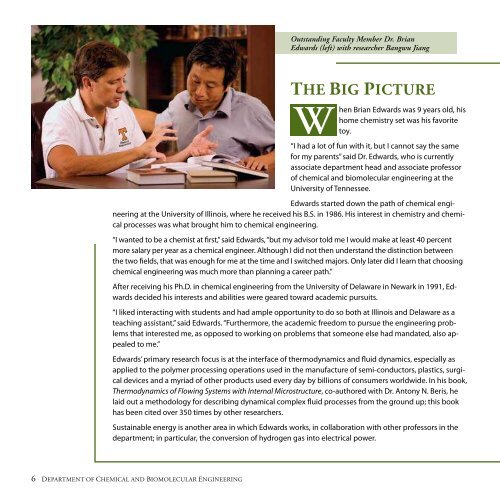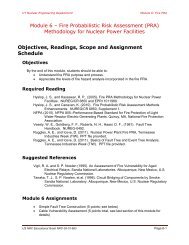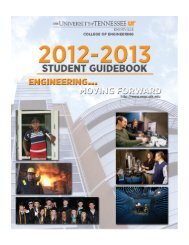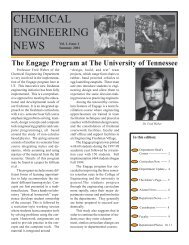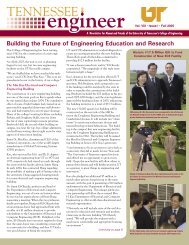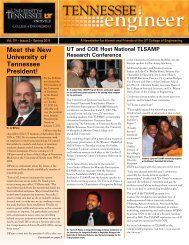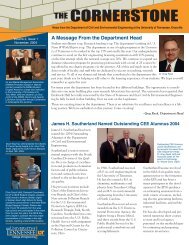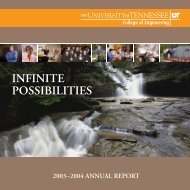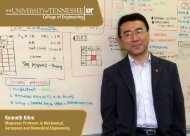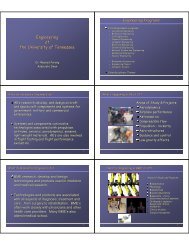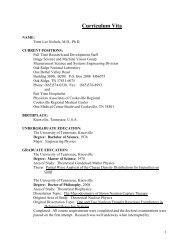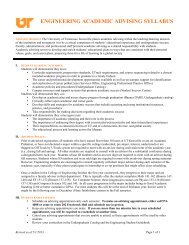CBE 2007 Annual Report - College of Engineering - The University ...
CBE 2007 Annual Report - College of Engineering - The University ...
CBE 2007 Annual Report - College of Engineering - The University ...
You also want an ePaper? Increase the reach of your titles
YUMPU automatically turns print PDFs into web optimized ePapers that Google loves.
Outstanding Faculty Member Dr. Brian<br />
Edwards (left) with researcher Bangwu Jiang<br />
THE BIG PICTURE<br />
W hen<br />
Brian Edwards was 9 years old, his<br />
home chemistry set was his favorite<br />
toy.<br />
“I had a lot <strong>of</strong> fun with it, but I cannot say the same<br />
for my parents” said Dr. Edwards, who is currently<br />
associate department head and associate pr<strong>of</strong>essor<br />
<strong>of</strong> chemical and biomolecular engineering at the<br />
<strong>University</strong> <strong>of</strong> Tennessee.<br />
Edwards started down the path <strong>of</strong> chemical engineering<br />
at the <strong>University</strong> <strong>of</strong> Illinois, where he received his B.S. in 1986. His interest in chemistry and chemical<br />
processes was what brought him to chemical engineering.<br />
“I wanted to be a chemist at first,” said Edwards, “but my advisor told me I would make at least 40 percent<br />
more salary per year as a chemical engineer. Although I did not then understand the distinction between<br />
the two fields, that was enough for me at the time and I switched majors. Only later did I learn that choosing<br />
chemical engineering was much more than planning a career path.”<br />
After receiving his Ph.D. in chemical engineering from the <strong>University</strong> <strong>of</strong> Delaware in Newark in 1991, Edwards<br />
decided his interests and abilities were geared toward academic pursuits.<br />
“I liked interacting with students and had ample opportunity to do so both at Illinois and Delaware as a<br />
teaching assistant,” said Edwards. “Furthermore, the academic freedom to pursue the engineering problems<br />
that interested me, as opposed to working on problems that someone else had mandated, also appealed<br />
to me.”<br />
Edwards’ primary research focus is at the interface <strong>of</strong> thermodynamics and fluid dynamics, especially as<br />
applied to the polymer processing operations used in the manufacture <strong>of</strong> semi-conductors, plastics, surgical<br />
devices and a myriad <strong>of</strong> other products used every day by billions <strong>of</strong> consumers worldwide. In his book,<br />
<strong>The</strong>rmodynamics <strong>of</strong> Flowing Systems with Internal Microstructure, co-authored with Dr. Antony N. Beris, he<br />
laid out a methodology for describing dynamical complex fluid processes from the ground up; this book<br />
has been cited over 350 times by other researchers.<br />
Sustainable energy is another area in which Edwards works, in collaboration with other pr<strong>of</strong>essors in the<br />
department; in particular, the conversion <strong>of</strong> hydrogen gas into electrical power.<br />
“I like to think about the big picture,” said Edwards. “Eventually,<br />
fossil fuels will dry up, maybe sooner than we expect. Alternative<br />
forms <strong>of</strong> energy are necessary, and hydrogen as a fuel has<br />
potential to impact energy use across the globe.”<br />
Fuel cells are part <strong>of</strong> this big picture for Edwards, who leads the<br />
Computational Materials Research Group with Dr. David Keffer,<br />
associate pr<strong>of</strong>essor <strong>of</strong> chemical and biomolecular engineering<br />
at UT. In a fuel cell, hydrogen enters and is split into protons<br />
and electrons by a platinum catalyst. For over 40 years, researchers<br />
have tried to understand how protons move through<br />
the electrode-electrolyte interface <strong>of</strong> fuel cells. With help from<br />
a Department <strong>of</strong> Energy grant, Edwards hopes to discover the<br />
answer through a computer model membrane he and Keffer<br />
created at the molecular level to look at the vehicular and structural<br />
diffusion that takes place with the cells.<br />
Edwards has also been recognized for his pr<strong>of</strong>essionalism in<br />
teaching and research. In 2003, he was awarded the <strong>College</strong><br />
<strong>of</strong> <strong>Engineering</strong> Outstanding Faculty Advisor Award and the<br />
Departmental Outstanding Teacher award. Four years later, Edwards<br />
was named a <strong>2007</strong> COE Research Fellow and received the<br />
Tom and Ruth Clark Award for Excellence in Chemical <strong>Engineering</strong><br />
Teaching.<br />
<strong>The</strong> primary reason Edwards joined the faculty at UT was that<br />
the <strong>College</strong> <strong>of</strong> <strong>Engineering</strong> and the Department <strong>of</strong> Chemical<br />
and Biomolecular <strong>Engineering</strong>, in particular, were poised for<br />
long-term and rapid growth.<br />
“I chose to teach at UT’s <strong>College</strong> <strong>of</strong> <strong>Engineering</strong> because I wanted<br />
to be part <strong>of</strong> building an imminent and sustainable national<br />
program <strong>of</strong> education and research in the chemical engineering<br />
pr<strong>of</strong>ession, rather than merely another cog in the machine<br />
<strong>of</strong> an already well-established institution.”<br />
<strong>CBE</strong> Department Maintains<br />
Continuous ABET Accreditation<br />
<strong>The</strong> Department <strong>of</strong> Chemical and Biomolecular <strong>Engineering</strong><br />
(<strong>CBE</strong>) was recently accredited for six more years<br />
through the Accreditation Board for <strong>Engineering</strong> and<br />
Technology (ABET), a non-governmental, peer-review<br />
body that certifies quality in engineering educational<br />
programs at the university level on a nationwide basis.<br />
Accreditation is not a ranking system, but instead ensures<br />
that rigorous standards <strong>of</strong> education, ethics, pr<strong>of</strong>essional<br />
development and lifelong learning are met. It also provides<br />
guidance to parents and<br />
students on which programs<br />
meet established quality standards.<br />
“In general, programs not certified<br />
by ABET are considered<br />
not to have a standard minimum<br />
quality,” said Dr. Masood<br />
Parang, associate dean for<br />
student affairs in the <strong>College</strong><br />
<strong>of</strong> <strong>Engineering</strong>. “Most employers are aware <strong>of</strong> the accreditation<br />
and would like to hire only graduates <strong>of</strong> the ABETaccredited<br />
engineering programs and schools.”<br />
ABET accreditation standards are set by pr<strong>of</strong>essionals<br />
through collaborative efforts <strong>of</strong> many technical and pr<strong>of</strong>essional<br />
societies. Although ABET accreditation is voluntary<br />
on the part <strong>of</strong> the institution, accreditation helps students<br />
and their parents choose quality college programs,<br />
and enables employers to recruit well-prepared graduates.<br />
Accreditation also gives colleges and universities a<br />
structured mechanism to assess, evaluate and improve<br />
the quality <strong>of</strong> their programs.<br />
6 DEPARTMENT OF CHEMICAL AND BIOMOLECULAR ENGINEERING <strong>2007</strong> ANNUAL REPORT 7


